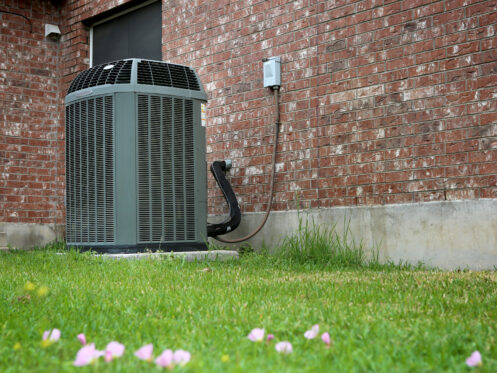Your heat pump offers several benefits. It keeps your home cool during the summer and warm during the winter. Indoor heat is absorbed through the refrigerant, which carries the heat toward the outside condenser coils. This is how the heat pump keeps your home cool during the summer. The process reverses to keep you warm in the winter. This differs from traditional AC systems that work only one way and which require an additional heating system.
There are two main parts to a heat pump. The outdoor unit holds the compressor and condenser coils, while the indoor unit has the evaporator coil and the air handler. Both units work together to stabilize your indoor climate regardless of season. The secret lies in a special piece called the reversing valve.
What’s the Reversing Valve?
Think of a reversing valve as a gateway for your heat pump. It grants the refrigerant enough leeway to travel in or out of your house as needed. This valve is best described as a metal bar flanked by several intersecting copper pieces. Depending on the temperature, it forms an electromagnetic force that guides refrigerant in or out of your home. When it’s hot outside, the reversing valve directs the refrigerant to the outside condenser coils to keep your house cool. During the winter, it does the opposite. It guides the refrigerant into your house to the indoor coil to keep your home warm. The reversing valve allows your heat pump to serve as both an air conditioner and a heater for your residence.
A valve acts as a traffic cop that guides and directs refrigerant where it needs to go. It guides the refrigerant from the compressor toward the heat coils for instant warmth. A tiny piece called a slide helps the heat pump by acting as a moderator for the refrigerant. It moves the liquid toward the indoors, where it transfers the heat from outside.
How Does the Slider Change Direction?
Obviously, the slider doesn’t change course on its own. The reversing valve causes the slider to move. What happens is that the reversing valve receives a signal from the thermostat and passes it off to the slider. The temperature signals the direction that the slider must move in to produce your selected indoor temperature. It acts as a modifier to direct which way the heat should be moved.
Refrigerant Defined
Refrigerant is the bloodline of most HVAC systems as it removes heat from the environment. This is known as a heat exchange. For heat pumps, it can transfer the heat in or out of your house. Refrigerant, in both gas and liquid form, circulates through heat pumps to produce a desired temperature. During a cycle, refrigerant undergoes pressure alterations to change from liquid to gas and back to liquid again.
Refrigerant amounts remain consistent during the process. No refrigerant is lost during its change between liquid and gas. The only time you’ll lose any of it is if you have a refrigerant leak, which a professional can diagnose.
The Heat Exchanger
How does a heat pump work so quickly and efficiently? The answer lies in the heat exchanger.
Most systems, such as boilers, generate heat from a source. But heat pumps use a different method. They utilize a heat exchanger, transferring heat from one area to another. Through this system, the compressor pushes the refrigerant through a cycle. From there, the heat exchanger extracts the heat and passes it over to the heat sink to another heat exchanger. This is how a heat pump keeps your home warm during the winter.
Which Climates Do Better With Heat Pumps?
In recent years, heat pumps have emerged as a climate-friendly alternative to traditional HVAC systems, which often use fossil fuel as a primary heat source. They first gained a foothold during the 1970s as an affordable way to keep your home warm during the winter.
Because heat pumps get their heat source from the outside, older systems can struggle to keep a home warm in climates that are colder. People living in the northern region of the United States were less likely to invest in one for their home. Instead, they tended to rely on traditional furnaces or boiler systems as a heat source for the winter.
During the early 2000s, people became more environmentally aware. Energy efficiency was embraced as a way to reduce costs and curb climate change. Heat pumps became a powerful tool that embraced these new trends.
These trends keep emerging as new technologies develop to make heat pumps more effective for all climates. The goal is to move households away from fossil fuel sources and toward methods that use alternative means to provide quality heat for the winter.
Technological Advances
Recent trends in new technology have improved heat pumps over the years. In fact, heat pumps are now being used in colder climates. People living as far north as Alaska are starting to use them in their homes.
How have new technologies improved heat pumps for use in colder regions? One major development is geothermal heat pumps. The ground remains at a relatively constant temperature throughout the year. A heat pump can extract heat from the ground to warm your home. Another development has to do with the indoor and outdoor fans. Both fans are now designed to achieve greater speed, thus increasing output during colder weather. Both dual and variable-speed technologies help keep the air moving at a reasonable speed, which moves hot air throughout a house.
Smart thermostat systems have emerged to boost heat pump efficiency during the winter. There are three main reasons to pair a smart thermostat with a heat pump. Smart thermostats have greater control over heat output, even while you’re away. They auto-adjust the heat settings according to your daily schedule. This reduces energy waste by having your heat pump operate only when necessary.
With a Wi-Fi-enabled smart thermostat, a remote monitoring system lets you control heat output from any location. You can adjust the heat pump settings using your mobile device. All you need is an app that’s compatible with your thermostat. You can easily adjust the thermostat settings for optimal comfort and cost savings. You can also view your savings from afar and make further modifications as needed.
Like most systems, heat pumps require routine maintenance to stay in tip-top shape. This includes catching any issues before they worsen. Smart technology can alert you when a problem arises. It also lets you know when it’s time for a routine check-up. We offer convenient maintenance plans to help keep your system in top shape.
Call the Pros
Installing a new heat pump requires the knowledge and expertise of an HVAC technician. You can rely on Agers Heating & Air Conditioning in the St. Louis and St. Peters areas for all your home heating needs. We provide installation, routine maintenance, upgrades, and more. Contact Agers Heating & Air Conditioning today for more information.




